
Lower Brandon Plantation is located on the south shore of the James River in present-day Prince George County, Virginia.
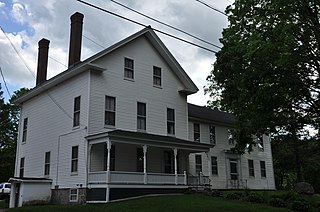
The Daniel Webster Family Home, also known as The Elms, is a historic house off South Main Street in West Franklin, New Hampshire. The house has been designated a National Historic Landmark for its importance as the summer home of Daniel Webster (1782–1852), who owned it from 1829 until his death.

The Moffatt-Ladd House, also known as the William Whipple House, is a historic house museum and National Historic Landmark in Portsmouth, New Hampshire, United States. The 1763 Georgian house was the home of William Whipple (1730–85), a signer of the Declaration of Independence and Revolutionary War general. The house is now owned by the National Society of Colonial Dames in New Hampshire, and is open to the public.
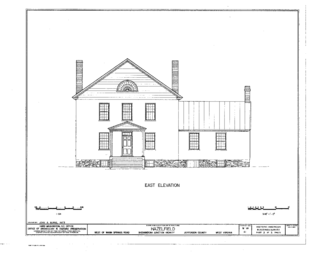
Hazelfield, located near Shenandoah Junction, West Virginia is a historic farm, whose principal residence was built in 1815 for Ann Stephen Dandridge Hunter.

Elmwood is a Federal style house near Shepherdstown, West Virginia. Located on land claimed in 1732 by Edward Lucas II, it was built in 1797 by his son, Edward Lucas III. During the Civil War the house was used as a field hospital. It remained in the Lucas family until 1948.
Belvedere, also known as Belvidere, was built near Charles Town, West Virginia by Magnus Tate II in 1807. The Federal style mansion is situated at the end of a tree-lined driveway and commands a sweeping view of the Blue Ridge Mountains. The house grew from the original "kitchen house" section to a formal three-bay brick main house built in 1824 by Magnus's son WIlliam, which were separate until they were connected in 1939.

Falling Spring at Morgan's Grove is part of a related complex of buildings and lands associated with the Morgan family and other prominent members of the Shepherdstown, West Virginia, community.
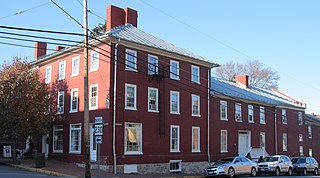
Rumsey Hall, also known as the Entler Hotel, is an historic building in Shepherdstown, West Virginia. The building is located in the center of the Shepherdstown Historic District and is a composite of six separate phases of construction. The earliest portion was built in 1786, and was the home belonging to Christian Cookus. This section burned in 1912. This section was separated by a narrow passage from the core of the hotel property, first started in the 1790s by owner Daniel Bedinger. This Federal style structure was expanded to the corner sometime before 1809, with a further addition along Princess Street by 1815. A kitchen and a carriage house completed the complex. Significant interior features remain. In 1809 a store was opened in the corner building, operated by James Brown. At about the same time, the Globe Tavern opened, offering overnight accommodations. In 1815, Bedinger sold the property to James Brown and Edward Lucas for $6,000. In 1820 it was again sold, to Thomas Crown of Washington, D.C., for $4000. By this time the tavern was managed by Thomas James and the hotel by Daniel Entler. In 1823, Daniel Entler became the manager of the entire property. The Entlers managed the properties until 1873, when they moved to Piedmont, West Virginia, while retaining ownership of the hotel.

The Captain William Lucas and Robert Lucas House, also known as Linden Spring, is a large stone house near Shepherdstown in Jefferson County, West Virginia, United States. It was built circa 1783 for Captain William Lucas, a Revolutionary War soldier. Lucas' son, Robert Lucas was born here and became a Governor of Ohio and the first Territorial governor of Iowa.
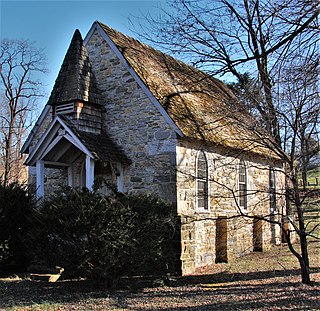
The Halltown Union Colored Sunday School, also known as the Halltown Memorial Chapel, in Halltown, West Virginia, was built in 1901 in the Gothic Revival style. The stone chapel was built by and for the local African-American community on a small parcel of land donated by Daniel B. Lucas from his Rion Hall estate, next to the Halltown Colored Free School. The non-denominational Sunday School operated until 1967, although the building continued in use for weddings and funerals. In 1982 a committee was formed to restore the building, which was carried out the next year.
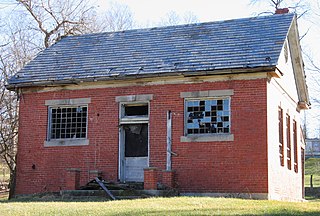
The Halltown Colored Free School in Halltown, West Virginia was built in 1870 to educate children from the African-American community in Halltown. The school was racially segregated from local schools for whites, in accordance with the laws of the time. It functioned in that capacity until 1929, when it was converted to a residence.

Gap View Farm, near Charles Town, West Virginia, is a historic farm complex built in 1774. The farm was placed on the National Register of Historic Places on January 9, 1997.

Cold Spring is a house near Shepherdstown, West Virginia, childhood home to two United States Representatives. The house was built by Edward Lucas III and his son, Robert in 1793.
Barleywood is a farm in Jefferson County, West Virginia, on land once owned by Samuel Washington, brother of George Washington. The farm is close to Samuel's manor house, Harewood, from which the Barleywood property was subdivided in 1841. The Barleywood house was built in 1842, as well as several outbuildings which survive. The house sat vacant from the 1960s to the late 2010s and during that time it suffered from vandalism. It is now a private residence.

Beall-Air, also known as the Colonel Lewis William Washington House, is a two-story stuccoed brick house in classical revival style near Halltown, West Virginia. It was the home of Colonel Lewis William Washington, great-great nephew of President George Washington and hostage in John Brown's raid on Harpers Ferry, West Virginia.

The Allstadt House and Ordinary was built about 1790 on land owned by the Lee family near Harpers Ferry, West Virginia, including Phillip Ludwell Lee, Richard Bland Lee and Henry Lee III. The house at the crossroads was sold to the Jacob Allstadt family of Berks County, Pennsylvania in 1811. Allstadt operated an ordinary in the house, and a tollgate on the Harpers Ferry-Charles Town Turnpike, while he resided farther down the road in a stone house. The house was enlarged by the Allstadts c. 1830. The house remained in the family until the death of John Thomas Allstadt in 1923, the last survivor of John Brown's Raid.

Rockland is the home of Virginia's Rust family, near Leesburg, Virginia. The property housed slaves to work their farm. The property was acquired by General George Rust from the heirs of Colonel Burgess Ball in 1817. General Rust built the present brick residence about 1822, incorporating an older frame house as a rear service wing.

Wirtland is a historic house in Westmoreland County, Virginia, United States, near the community of Oak Grove. Built in 1850 by William Wirt, Jr., the son of former U.S. Attorney General William Wirt, it has been recognized as a high-quality example of a rural Gothic Revival house of the period. Its historic status was recognized in 1979, when it was listed on the National Register of Historic Places.
The William Boggs Farm is located in the Back Creek Valley of Berkeley County, West Virginia ner Hedgesville. The property was settled before 1750 by William Boggs, who may have been the first settler in the valley. A 1750 survey indicates that Boggs had 275 acres (111 ha) of land with a cabin. By 1766 Boggs had accumulated 527 acres (213 ha). Boggs grew cash crops in the fertile bottomlands along Back Creek and raised clover for pasturage on the hilltops.

Henderson Hall Historic District is a National Register of Historic Places (NRHP)-listed historic district in Boaz, Wood County, West Virginia. The primary contributing property is Henderson Hall, a home in the Italianate style from the first half of the 19th century. Other residences at the site are a tenant house from the end of the 19th century, and "Woodhaven", the 1877 home of Henry Clay Henderson. Additional structures include a smokehouse, two corn cribs, a carriage barn that also served as a schoolhouse, a scale house used for storing agricultural equipment, and two barns. Also included within the district are the 19th-century Henderson family cemetery, a wall, a mounting block, and three mounds associated with the pre-Columbian Adena culture.



















